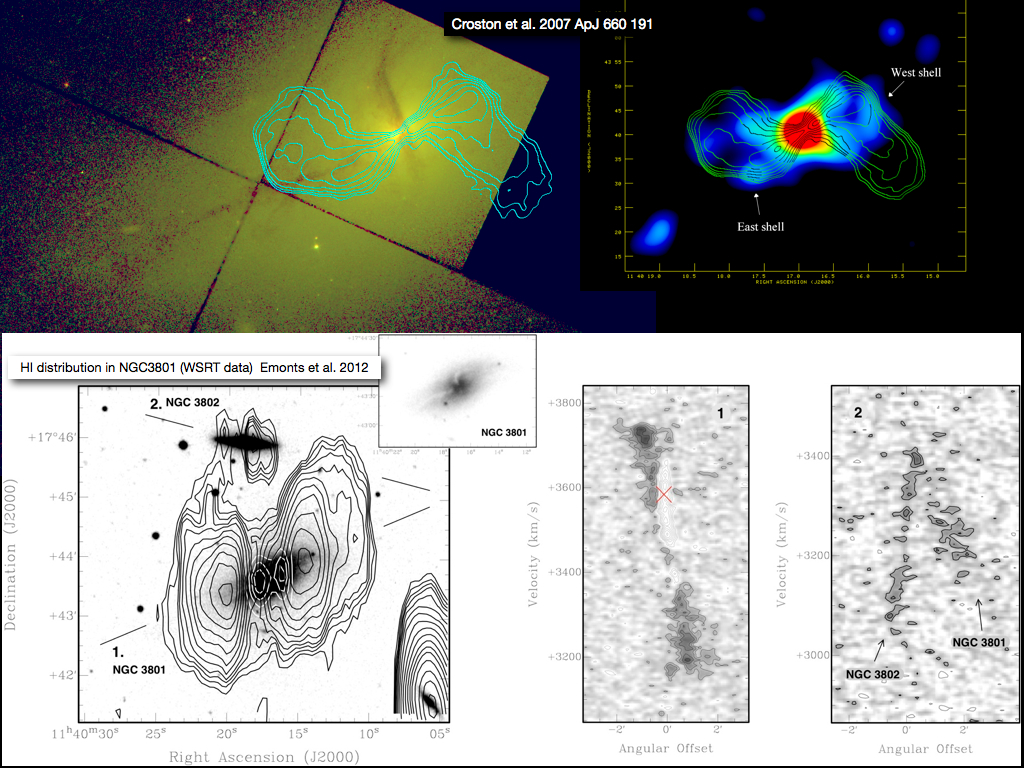Daily Image
10-04-2012NGC 3801: classical radio source propagating into outer H I disc
| Submitter: | Bjorn Emonts, Raffaella Morganti |
| Description: | It is know that there is are interdependences between the development of radio sources emanating from supermassive black holes and the evolution of their surrounding host galaxies. The nearby Universe gives us a chance to study in detail some of the physical processes related to this mutual evolution between AGN and host galaxy. One excellent system for such studies is the nearby radio galaxy NGC 3801. There is evidence from optical imaging that NGC 3801 went through a past merger event. Using the Westerbork Synthesis Radio Telescope, we discovered that NGC 3801 contains a large-scale disc of neutral hydrogen (HI) gas, with diameter of over 100.000 light-years (34 kpc) and an HI mass of 1.3 billion solar masses. The WSRT data also shows evidence for an ongoing interaction between NGC 3801 and its smaller companion NGC 3802. The most striking result is that the HI disc in NGC 3801 is aligned with the radio jet axis, which means that the radio source is propagating straight into the disc. This makes NGC 3801 an ideal case for studying the evolution of the radio source through its surrounding inter-stellar medium. Interestingly, although the radio source is rather small (11 kpc), its total power and jet morphology are typical for edge-darkened Fanaroff & Riley type-I (FR-I) sources. However, the large HI content, combined with over-pressured radio jets and an obscuring torus detected in X-rays by Croston et al (2007), are properties that are generally not, or no longer, associated with more evolved FR-I source. Instead, these properties are commonly found among high-excitation AGN, such as 'hot-spot'-type FR-II sources as well as Seyfert galaxies. In terms of HI properties, NGC 3801 does show similarities with a significant fraction of nearby low-power compact radio sources, which we found to be hosted by galaxies with enormous HI discs (Emonts et al 2010). Studies of radio-AGN like NGC 3801 may therefore reveal important insight into a more general phase in the early evolution of at least a significant fraction of radio galaxies. The above results are published in "Classical radio source propagating into outer H I disc in NGC 3801" Emonts, Burnett, Morganti & Struve MNRAS 2012 http://arxiv.org/abs/1112.5221) Figure caption: NGC 3801 in radio continuum, X-rays and HI emission. Top left: 1.4 GHz radio continuum (Croston et al 2007) overlaid onto an HST image of the central region. The radio contours show the typical FR-I radio morphology, while in the HST image two perpendicular dust-lanes are visible. Top right: 1.4 GHz radio continuum overlaid onto X-ray image, showing shells of hot X-ray gas that reveal that the jets are over-pressured (from Croston et al 2007). Bottom: Total intensity map (left) and position-velocity plots (right) of the HI gas in the disc of NGC 3801 (from Emonts et al 2012). The red cross marks the location of a clump of cold molecular CO gas in the HI disc (Das et al. 2005). |
| Copyright: | Emonts/Morganti |
| Tweet |  |
